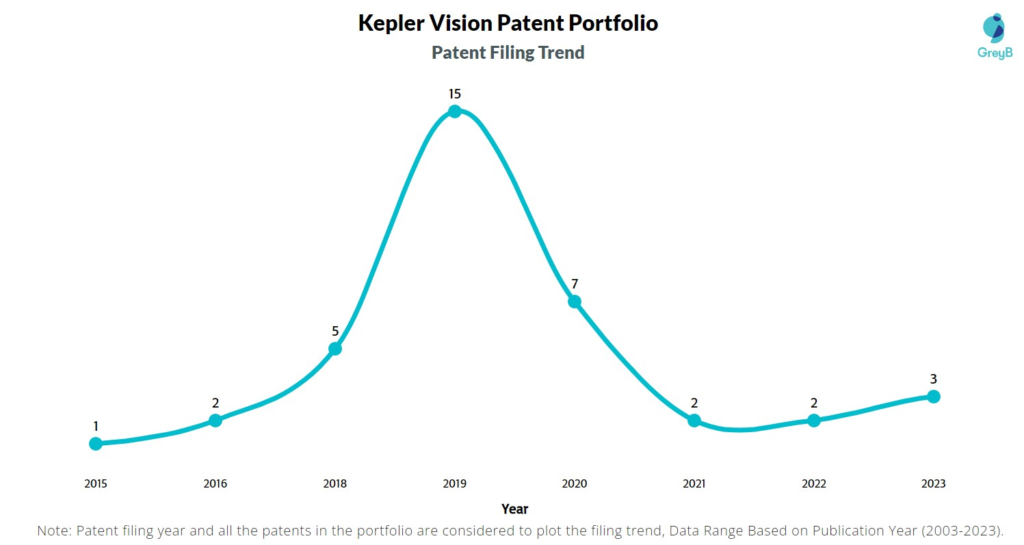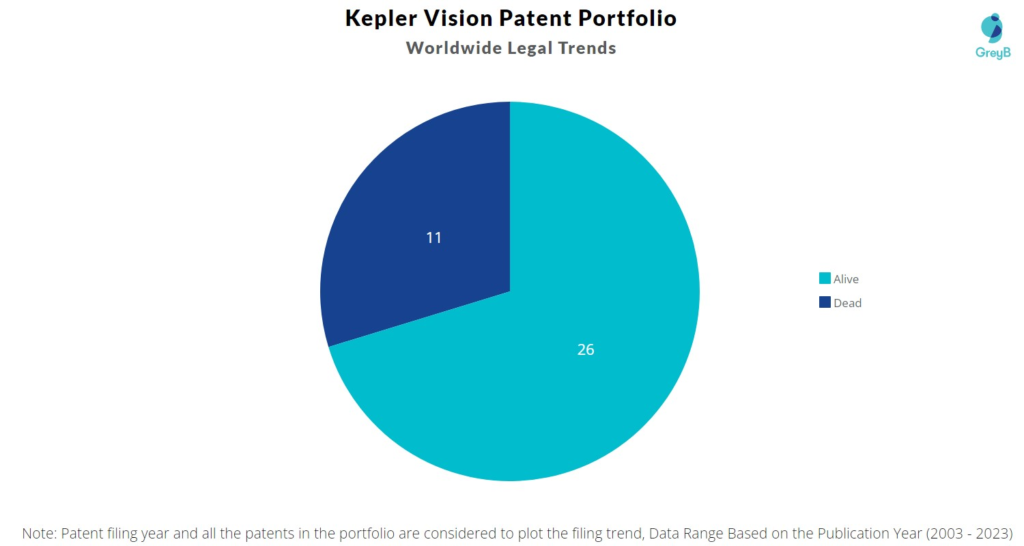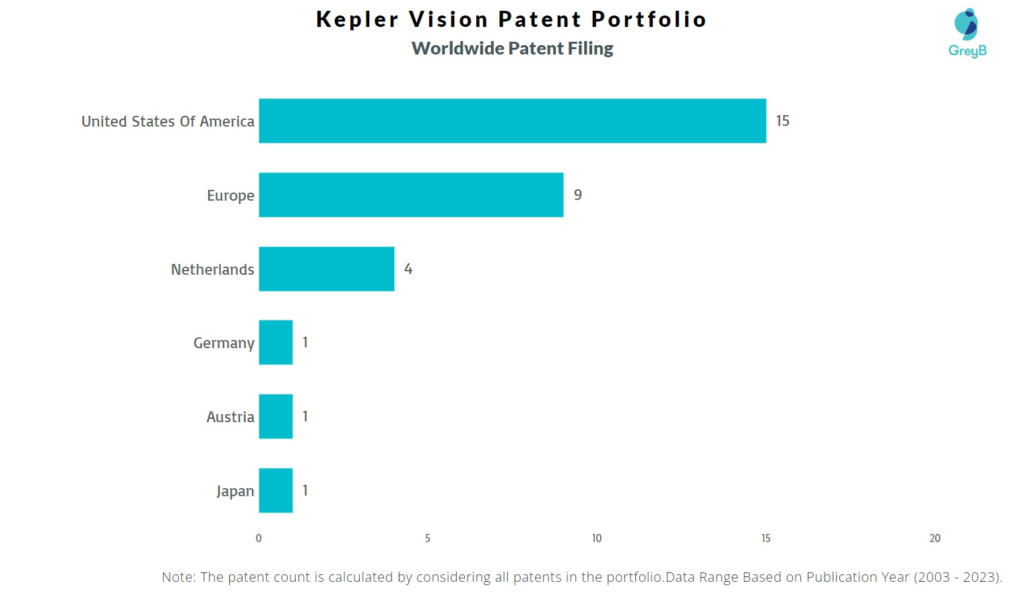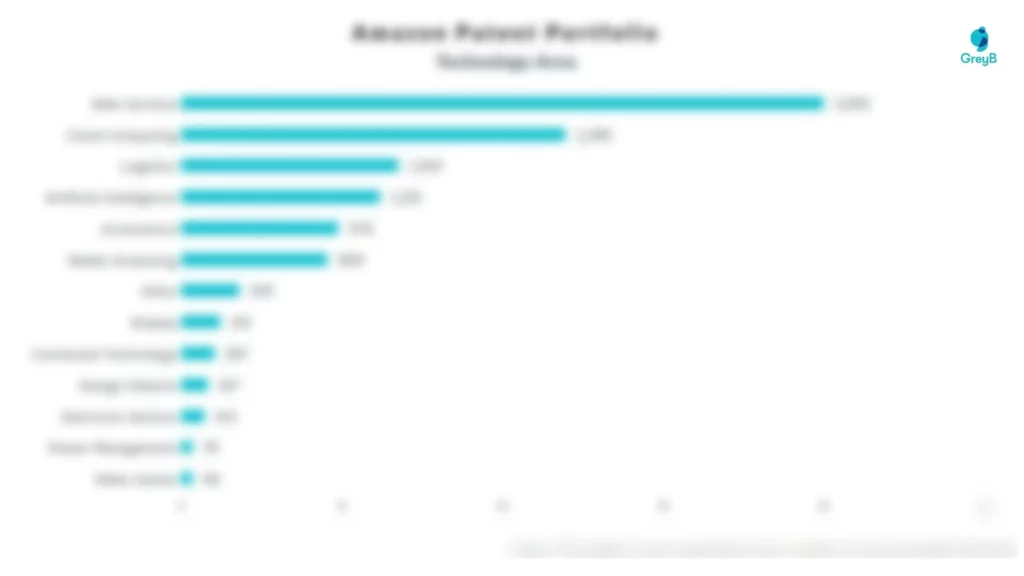Kepler Vision has a total of 37 patents globally, out of which 13 have been granted. Of these 37 patents, more than 70% patents are active. United States of America is where Kepler Vision has filed the maximum number of patents, followed by Europe and Netherlands. Parallelly, Netherlands seems to be the main focused R&D centre and also is the origin country of Kepler Vision.
Kepler Vision was founded in the year 2018. The Company develops an AI that looks after the well-being of humans.
Do read about some of the most popular patents of Kepler Vision which have been covered by us in this article and also you can find Kepler Vision patents information, the worldwide patent filing activity and its patent filing trend over the years, and many other stats over Kepler Vision patent portfolio.
How many patents does Kepler Vision have?
Kepler Vision has a total of 37 patents globally. These patents belong to 10 unique patent families. Out of 37 patents, 26 patents are active.
How Many Patents did Kepler Vision File Every Year?

Are you wondering why there is a drop in patent filing for the last two years? It is because a patent application can take up to 18 months to get published. Certainly, it doesn’t suggest a decrease in the patent filing.
| Year of Patents Filing or Grant | Kepler Vision Applications Filed | Kepler Vision Patents Granted |
| 2023 | 3 | 2 |
| 2022 | 2 | 2 |
| 2021 | 2 | 3 |
| 2020 | 7 | 3 |
| 2019 | 15 | 2 |
| 2018 | 5 | – |
| 2016 | 2 | 1 |
| 2015 | 1 | – |
How many Kepler Vision patents are Alive/Dead?

How Many Patents did Kepler Vision File in Different Countries?

Countries in which Kepler Vision Filed Patents
| Country | Patents |
| United States Of America | 15 |
| Europe | 9 |
| Netherlands | 4 |
| Germany | 1 |
| Austria | 1 |
| Japan | 1 |
Where are Research Centres of Kepler Vision Patents Located?

What Percentage of Kepler Vision US Patent Applications were Granted?
Kepler Vision (Excluding its subsidiaries) has filed 10 patent applications at USPTO so far (Excluding Design and PCT applications). Out of these 4 have been granted leading to a grant rate of 100.0%.
Below are the key stats of Kepler Vision patent prosecution at the USPTO.

Which Law Firms Filed Most US Patents for Kepler Vision?
| Law Firm | Total Applications | Success Rate |
| Aeon Law | 10 | 100.00% |
List of Kepler Vision Patents
| Kepler Vision Patents | Title |
| US11688062B2 | Medical Device For Transcription Of Appearances In An Image To Text With Machine Learning |
| US11681950B2 | Method For Categorizing A Scene Comprising A Sub-Scene With Machine Learning |
| US11443557B2 | Monitoring And Analyzing Body Language With Machine Learning, Using Artificial Intelligence Systems For Improving Interaction Between Humans, And Humans And Robots |
| US11308358B2 | Method And System For Automatically Annotating And Identifying A Living Being Or An Object With An Identifier Providing A Subject Identification |
| US11210499B2 | Determining A Social Group To Which Customers Belong From Appearance And Using Artificial Intelligence, Machine Learning, And Computer Vision, For Estimating Customer Preferences And Intent, And For Improving Customer Services |
| US10839220B2 | Method For Categorizing A Scene Comprising A Sub-Scene With Machine Learning |
| US10607117B2 | Deep Receptive Field Networks |
| US20230281813A1 | Medical Device For Transcription Of Appearances In An Image To Text With Machine Learning |
| US20230281514A1 | Method For Categorizing A Scene Comprising A Sub-Scene With Machine Learning |
| US20230041117A1 | Monitoring And Analyzing Body Language With Machine Learning, Using Artificial Intelligence Systems For Improving Interaction Between Humans, And Humans And Robots |
| US20220237413A1 | Method And System For Automatically Annotating And Identifying A Living Being Or An Object With An Identifier Providing A Subject Identification |
| US20210352207A1 | Method For Adapting The Quality And/Or Frame Rate Of A Live Video Stream Based Upon Pose |
| US20210110922A1 | System To Notify A Request For Help By Detecting An Intent To Press A Button, Said System Using Artificial Intelligence |
| US20210097351A1 | Adaptive Artificial Intelligence System For Event Categorizing By Switching Between Different States |
| EP3596656B1 | Monitoring And Analyzing Body Language With Machine Learning, Using Artificial Intelligence Systems For Improving Interaction Between Humans, And Humans And Robots |
| EP3942495A1 | Medical Device For Transcription Of Appearances In An Image To Text With Machine Learning |
| EP3910541A1 | Method For Adapting The Quality And/Or Frame Rate Of A Live Video Stream Based Upon Pose |
| EP3841520A1 | A Method For Categorizing A Scene Comprising A Sub-Scene With Machine Learning |
| EP3805980A1 | System To Notify A Request For Help By Detecting An Intent To Press A Button, Said System Using Artificial Intelligence |
| EP3776368A1 | Adaptive Artificial Intelligence System For Event Categorizing By Switching Between Different States |
| EP3740894A1 | Method And System For Automatically Annotating And Identifying A Living Being Or An Object With An Identifier Providing A Subject Identification |
| WO2023148360A1 | Detecting A Missed Event When Monitoring A Video With Computer Vision At A Low Frame Rate |
| DE602019004508T2 | Monitoring And Analysis Of Body Language With Machine Learning Using Artificial Intelligence Systems To Improve Interaction Between Humans And Humans And Robots |
| NL2021481B1 | A Method For Automatically Annotating And Identifying A Living Being Or An Object With An Identifier, Such As Rfid, And Computer Vision. |
| NL2020989B1 | Monitoring And Analyzing Body Language With Machine Learning, Using Artificial Intelligence Systems For Improving Interaction Between Humans, And Humans And Robots. |
| NL2020685B1 | Adaptive Artificial Intelligence System For Event Categorizing By Switching Between Different States. |
| US20200226427A1 | Deep Receptive Field Networks |
| EP3907652A1 | Method For Adapting The Quality And/Or Frame Rate Of A Live Video Stream Based Upon Pose |
| EP3304424A2 | Deep Receptive Field Networks |
| WO2020188119A1 | Medical Device For Transcription Of Appearances In An Image To Text With Machine Learning |
| WO2020079008A1 | A Method For Categorizing A Scene Comprising A Sub-Scene With Machine Learning |
| WO2020036490A1 | Method And System For Automatically Annotating And Identifying A Living Being Or An Object With An Identifier Providing A Subject Identification |
| WO2019226051A1 | Monitoring And Analyzing Body Language With Machine Learning, Using Artificial Intelligence Systems For Improving Interaction Between Humans, And Humans And Robots |
| WO2019190312A1 | Adaptive Artificial Intelligence System For Event Categorizing By Switching Between Different States |
| NL2015087B1 | Deep Receptive Field Networks. |
| AT1390730T | How To Analyze And Analyze The Problems In The System |
| JP2022512028A | How To Classify Scenes With Subscenes By Machine Learning |
What are Kepler Vision key innovation segments?
What Technologies are Covered by Kepler Vision?

The chart below distributes patents filed by Kepler Vision
